| Listing 1 - 10 of 14 | << page >> |
Sort by
|
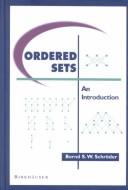
ISBN: 0817641289 3764341289 1461265916 1461200539 Year: 2003 Publisher: Boston : Birkhäuser,
Abstract | Keywords | Export | Availability | Bookmark
 Loading...
Loading...Choose an application
- Reference Manager
- EndNote
- RefWorks (Direct export to RefWorks)
This work is an introduction to the basic tools of the theory of (partially) ordered sets such as visualization via diagrams, subsets, homomorphisms, important order-theoretical constructions, and classes of ordered sets. Using a thematic approach, the author presents open or recently solved problems to motivate the development of constructions and investigations for new classes of ordered sets. A wide range of material is presented, from classical results such as Dilworth's, Szpilrajn's and Hashimoto's Theorems to more recent results such as the Li--Milner Structure Theorem. Major topics covered include: chains and antichains, lowest upper and greatest lower bounds, retractions, lattices, the dimension of ordered sets, interval orders, lexicographic sums, products, enumeration, algorithmic approaches and the role of algebraic topology. Since there are few prerequisites, the text can be used as a focused follow-up or companion to a first proof (set theory and relations) or graph theory class. After working through a comparatively lean core, the reader can choose from a diverse range of topics such as structure theory, enumeration or algorithmic aspects. Also presented are some key topics less customary to discrete mathematics/graph theory, including a concise introduction to homology for graphs, and the presentation of forward checking as a more efficient alternative to the standard backtracking algorithm. The coverage throughout provides a solid foundation upon which research can be started by a mathematically mature reader. Rich in exercises, illustrations, and open problems, Ordered Sets: An Introduction is an excellent text for undergraduate and graduate students and a good resource for the interested researcher. Readers will discover order theory's role in discrete mathematics as a supplier of ideas as well as an attractive source of applications.
Ordered sets --- Ensembles ordonnés --- Ensembles ordonnés --- Ensembles ordonnés. --- Mathematical logic. --- Algebra. --- Ordered algebraic structures. --- Combinatorics. --- Algebraic topology. --- Mathematical Logic and Foundations. --- Order, Lattices, Ordered Algebraic Structures. --- Algebraic Topology. --- Topology --- Combinatorics --- Algebra --- Mathematical analysis --- Algebraic structures, Ordered --- Structures, Ordered algebraic --- Mathematics --- Algebra of logic --- Logic, Universal --- Mathematical logic --- Symbolic and mathematical logic --- Symbolic logic --- Algebra, Abstract --- Metamathematics --- Set theory --- Syllogism

ISBN: 1402013302 1402013310 9400708122 9781402013300 9781402013317 Year: 2003 Volume: 19 Publisher: Dordrecht: Kluwer academic,
Abstract | Keywords | Export | Availability | Bookmark
 Loading...
Loading...Choose an application
- Reference Manager
- EndNote
- RefWorks (Direct export to RefWorks)
Since its birth, Model Theory has been developing a number of methods and concepts that have their intrinsic relevance, but also provide fruitful and notable applications in various fields of Mathematics. It is a lively and fertile research area which deserves the attention of the mathematical world. This volume: -is easily accessible to young people and mathematicians unfamiliar with logic; -gives a terse historical picture of Model Theory; -introduces the latest developments in the area; -provides 'hands-on' proofs of elimination of quantifiers, elimination of imaginaries and other relevant matters. A Guide to Classical and Modern Model Theory is for trainees and professional model theorists, mathematicians working in Algebra and Geometry and young people with a basic knowledge of logic.
Model theory --- Model theory. --- Logic. --- Mathematical logic. --- Algebra. --- Mathematical Logic and Foundations. --- Mathematics --- Mathematical analysis --- Algebra of logic --- Logic, Universal --- Mathematical logic --- Symbolic and mathematical logic --- Symbolic logic --- Algebra, Abstract --- Metamathematics --- Set theory --- Syllogism --- Argumentation --- Deduction (Logic) --- Deductive logic --- Dialectic (Logic) --- Logic, Deductive --- Intellect --- Philosophy --- Psychology --- Science --- Reasoning --- Thought and thinking --- Methodology

ISSN: 14397382 ISBN: 3540440852 9786610902095 1280902094 354044761X 9783540440857 Year: 2003 Publisher: Berlin ; New York : Springer,
Abstract | Keywords | Export | Availability | Bookmark
 Loading...
Loading...Choose an application
- Reference Manager
- EndNote
- RefWorks (Direct export to RefWorks)
Set Theory has experienced a rapid development in recent years, with major advances in forcing, inner models, large cardinals and descriptive set theory. The present book covers each of these areas, giving the reader an understanding of the ideas involved. It can be used for introductory students and is broad and deep enough to bring the reader near the boundaries of current research. Students and researchers in the field will find the book invaluable both as a study material and as a desktop reference.
Set theory --- Set theory. --- Théorie des ensembles --- Mathematical logic. --- Mathematical Logic and Foundations. --- Mathematical Logic and Formal Languages. --- Algebra of logic --- Logic, Universal --- Mathematical logic --- Symbolic and mathematical logic --- Symbolic logic --- Mathematics --- Algebra, Abstract --- Metamathematics --- Syllogism --- Aggregates --- Classes (Mathematics) --- Ensembles (Mathematics) --- Mathematical sets --- Sets (Mathematics) --- Theory of sets --- Logic, Symbolic and mathematical
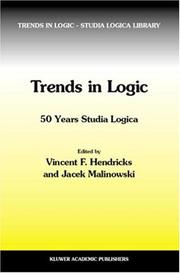
ISBN: 1402016018 9048164141 9401735980 9781402016011 Year: 2003 Volume: 21 Publisher: Dordrecht : Kluwer academic,
Abstract | Keywords | Export | Availability | Bookmark
 Loading...
Loading...Choose an application
- Reference Manager
- EndNote
- RefWorks (Direct export to RefWorks)
Logic --- History. --- History --- Logic. --- Coding theory. --- Information theory. --- Mathematical logic. --- Coding and Information Theory. --- Mathematical Logic and Foundations. --- Algebra of logic --- Logic, Universal --- Mathematical logic --- Symbolic and mathematical logic --- Symbolic logic --- Mathematics --- Algebra, Abstract --- Metamathematics --- Set theory --- Syllogism --- Communication theory --- Communication --- Cybernetics --- Data compression (Telecommunication) --- Digital electronics --- Information theory --- Machine theory --- Signal theory (Telecommunication) --- Computer programming --- Argumentation --- Deduction (Logic) --- Deductive logic --- Dialectic (Logic) --- Logic, Deductive --- Intellect --- Philosophy --- Psychology --- Science --- Reasoning --- Thought and thinking --- Methodology --- Logic - History.
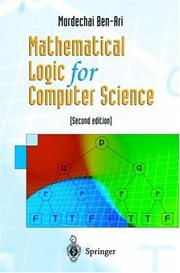
ISBN: 1852333197 1447103351 9781852333195 Year: 2003 Publisher: London Springer
Abstract | Keywords | Export | Availability | Bookmark
 Loading...
Loading...Choose an application
- Reference Manager
- EndNote
- RefWorks (Direct export to RefWorks)
Mathematical Logic for Computer Science is a mathematics textbook with theorems and proofs, but the choice of topics has been guided by the needs of computer science students. The method of semantic tableaux provides an elegant way to teach logic that is both theoretically sound and yet sufficiently elementary for undergraduates. To provide a balanced treatment of logic, tableaux are related to deductive proof systems. The logical systems presented are: - Propositional calculus (including binary decision diagrams); - Predicate calculus; - Resolution; - Hoare logic; - Z; - Temporal logic. Answers to exercises (for instructors only) as well as Prolog source code for algorithms may be found via the Springer London web site: http://www.springer.com/978-1-85233-319-5 Mordechai Ben-Ari is an associate professor in the Department of Science Teaching of the Weizmann Institute of Science. He is the author of numerous textbooks on concurrency, programming languages and logic, and has developed software tools for teaching concurrency. In 2004, Ben-Ari received the ACM/SIGCSE Award for Outstanding Contributions to Computer Science Education.
Logic, Symbolic and mathematical --- Logic, Symbolic and mathematical. --- Mathematical logic --- Computer. Automation --- Computers. --- Mathematical logic. --- Theory of Computation. --- Mathematical Logic and Foundations. --- Mathematical Logic and Formal Languages. --- Algebra of logic --- Logic, Universal --- Symbolic and mathematical logic --- Symbolic logic --- Mathematics --- Algebra, Abstract --- Metamathematics --- Set theory --- Syllogism --- Automatic computers --- Automatic data processors --- Computer hardware --- Computing machines (Computers) --- Electronic brains --- Electronic calculating-machines --- Electronic computers --- Hardware, Computer --- Computer systems --- Cybernetics --- Machine theory --- Calculators --- Cyberspace

ISBN: 1402012705 0306480883 Year: 2003 Publisher: Dordrecht : Springer Netherlands,
Abstract | Keywords | Export | Availability | Bookmark
 Loading...
Loading...Choose an application
- Reference Manager
- EndNote
- RefWorks (Direct export to RefWorks)
The study of information-based actions and processes has been a vibrant - terface between logic and computer science for several decades now. Indeed, several natural perspectives come together here. On the one hand, logical s- tems may be used to describe the dynamics of arbitrary computational p- cesses – as in the many sophisticated process logics available today. But also, key logical notions such as model checking or proof search are themselves informational processes involving agents with goals. The interplay between these descriptive and dynamic aspects shows even in our ordinary language. A word like “proof” hdenotes both a static ‘certificate’ of truth, and an activity which humans or machines engage in. Increasing our understanding of l- ics of this sort tells us something about computer science, and about cognitive actions in general. The individual chapters of this book show the state of the art in current - vestigations of process calculi such as linear logic, and – with mainly two major paradigms at work, namely, linear logic and modal logic. These techniques are applied to the title themes of concurrency and synchronisation, but there are also many repercussions for topics such as the geometry of proofs, categorial semantics, and logics of graphs. Viewed - gether, the chapters also offer exciting glimpses of future integration, as the reader moves back and forth through the book.
Modality (Logic). --- Parallel programming (Computer science). --- Proof theory. --- Mathematics. --- Logic. --- Architecture, Computer. --- Computers. --- Mathematical logic. --- Mathematical Logic and Foundations. --- Computer System Implementation. --- Theory of Computation. --- Algebra of logic --- Logic, Universal --- Mathematical logic --- Symbolic and mathematical logic --- Symbolic logic --- Mathematics --- Algebra, Abstract --- Metamathematics --- Set theory --- Syllogism --- Automatic computers --- Automatic data processors --- Computer hardware --- Computing machines (Computers) --- Electronic brains --- Electronic calculating-machines --- Electronic computers --- Hardware, Computer --- Computer systems --- Cybernetics --- Machine theory --- Calculators --- Cyberspace --- Architecture, Computer --- Argumentation --- Deduction (Logic) --- Deductive logic --- Dialectic (Logic) --- Logic, Deductive --- Intellect --- Philosophy --- Psychology --- Science --- Reasoning --- Thought and thinking --- Math --- Methodology

ISBN: 1280188332 9786610188338 0387215603 0387008349 9780387008349 Year: 2003 Publisher: New York (N.Y.): Springer
Abstract | Keywords | Export | Availability | Bookmark
 Loading...
Loading...Choose an application
- Reference Manager
- EndNote
- RefWorks (Direct export to RefWorks)
This book, which is based on Pólya's method of problem solving, aids students in their transition from calculus (or precalculus) to higher-level mathematics. The book begins by providing a great deal of guidance on how to approach definitions, examples, and theorems in mathematics. It ends by providing projects for independent study. Students will follow Pólya's four step process: learn to understand the problem; devise a plan to solve the problem; carry out that plan; and look back and check what the results told them. Special emphasis is placed on reading carefully and writing well. The authors have included a wide variety of examples, exercises with solutions, problems, and over 40 illustrations, chosen to emphasize these goals. Historical connections are made throughout the text, and students are encouraged to use the rather extensive bibliography to begin making connections of their own. While standard texts in this area prepare students for future courses in algebra, this book also includes chapters on sequences, convergence, and metric spaces for those wanting to bridge the gap between the standard course in calculus and one in analysis.
Mathematics --- Technical writing --- Mathematics Teaching & Research --- Physical Sciences & Mathematics --- Study and teaching (Higher) --- 51:37 --- -Technical writing --- -Engineering --- Science --- Scientific writing --- Technology --- Authorship --- Communication of technical information --- Math --- 51:37 Mathematics-:-Opvoeding en onderwijs --(algemeen) --- Mathematics-:-Opvoeding en onderwijs --(algemeen) --- -Study and teaching (Higher) --- -Social aspects --- Mathématiques --- Rédaction technique --- Etude et enseignement (Supérieur) --- EPUB-LIV-FT SPRINGER-B --- Mathematics. --- Mathematical analysis. --- Analysis (Mathematics). --- Mathematical logic. --- Number theory. --- Mathematical Logic and Foundations. --- Analysis. --- Number Theory. --- Engineering --- Logic, Symbolic and mathematical. --- Global analysis (Mathematics). --- Number study --- Numbers, Theory of --- Algebra --- 517.1 Mathematical analysis --- Mathematical analysis --- Algebra of logic --- Logic, Universal --- Mathematical logic --- Symbolic and mathematical logic --- Symbolic logic --- Algebra, Abstract --- Metamathematics --- Set theory --- Syllogism
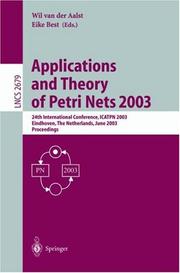
ISBN: 3540403345 3540449191 Year: 2003 Publisher: Germany : Springer,
Abstract | Keywords | Export | Availability | Bookmark
 Loading...
Loading...Choose an application
- Reference Manager
- EndNote
- RefWorks (Direct export to RefWorks)
Petri nets -- Congresses. --- Petri nets --- Computer science. --- Computer organization. --- Software engineering. --- Computers. --- Mathematical logic. --- Computer Science. --- Software Engineering/Programming and Operating Systems. --- Mathematical Logic and Foundations. --- Theory of Computation. --- Computation by Abstract Devices. --- Computer Systems Organization and Communication Networks. --- Software Engineering. --- Algebra of logic --- Logic, Universal --- Mathematical logic --- Symbolic and mathematical logic --- Symbolic logic --- Mathematics --- Algebra, Abstract --- Metamathematics --- Set theory --- Syllogism --- Automatic computers --- Automatic data processors --- Computer hardware --- Computing machines (Computers) --- Electronic brains --- Electronic calculating-machines --- Electronic computers --- Hardware, Computer --- Computer systems --- Cybernetics --- Machine theory --- Calculators --- Cyberspace --- Computer software engineering --- Engineering --- Organization, Computer --- Electronic digital computers --- Informatics --- Science --- Logic, Symbolic and mathematical. --- Information theory. --- Computer network architectures. --- Communication theory --- Communication --- Architectures, Computer network --- Network architectures, Computer --- Computer architecture
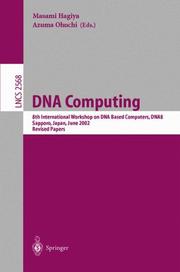
ISBN: 3540005315 3540364404 Year: 2003 Publisher: Berlin, Heidelberg : Springer Berlin Heidelberg : Imprint: Springer,
Abstract | Keywords | Export | Availability | Bookmark
 Loading...
Loading...Choose an application
- Reference Manager
- EndNote
- RefWorks (Direct export to RefWorks)
Biomolecular computing has emerged as an interdisciplinary ?eld that draws - gether chemistry, computer science, mathematics, molecular biology, and physics. Our knowledge on DNA nanotechnology and biomolecular computing increases exponentially with every passing year. The international meeting on DNA Based Computers has been a forum where scientists with di?erent backgrounds, yet sharing a common interest in biomolecular computing, meet and present their latest results. Continuing this tradition, the 8th International Meeting on DNA Based Computers (DNA8) focuses on the current theoretical and experimental results with the greatest impact. Papers and poster presentations were sought in all areas that relate to b- molecular computing, including (but not restricted to): algorithms and appli- tions, analysis of laboratory techniques/theoretical models, computational p- cesses in vitro and in vivo, DNA-computing-based biotechnological applications, DNA devices, error evaluation and correction, in vitro evolution, models of biomolecular computing (using DNA and/or other molecules), molecular - sign, nucleic acid chemistry, and simulation tools. Papers and posters with new experimental results were particularly encouraged. Authors who wished their work to be considered for either oral or poster presentation were asked to select from one of two submission “tracks”: – Track A - Full Paper – Track B - One-Page Abstract For authors with late-breaking results, or who were submitting their manuscript to a scienti?c journal, a one-page abstract, rather than a full paper, could be submitted in Track B. Authors could (optionally) include a preprint of their full paper, for consideration only by the program committee.
Molecular computers --- Computer Science --- Engineering & Applied Sciences --- Mathematics. --- Computers. --- Algorithms. --- Artificial intelligence. --- Bioinformatics. --- Mathematical logic. --- Mathematical Logic and Foundations. --- Computation by Abstract Devices. --- Algorithm Analysis and Problem Complexity. --- Artificial Intelligence (incl. Robotics). --- Algebra of logic --- Logic, Universal --- Mathematical logic --- Symbolic and mathematical logic --- Symbolic logic --- Mathematics --- Algebra, Abstract --- Metamathematics --- Set theory --- Syllogism --- Bio-informatics --- Biological informatics --- Biology --- Information science --- Computational biology --- Systems biology --- AI (Artificial intelligence) --- Artificial thinking --- Electronic brains --- Intellectronics --- Intelligence, Artificial --- Intelligent machines --- Machine intelligence --- Thinking, Artificial --- Bionics --- Cognitive science --- Digital computer simulation --- Electronic data processing --- Logic machines --- Machine theory --- Self-organizing systems --- Simulation methods --- Fifth generation computers --- Neural computers --- Algorism --- Algebra --- Arithmetic --- Automatic computers --- Automatic data processors --- Computer hardware --- Computing machines (Computers) --- Electronic calculating-machines --- Electronic computers --- Hardware, Computer --- Computer systems --- Cybernetics --- Calculators --- Cyberspace --- Math --- Science --- Data processing --- Foundations --- Logic, Symbolic and mathematical. --- Computer science. --- Computer software. --- Artificial Intelligence. --- Software, Computer --- Informatics
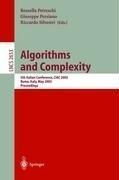
ISBN: 3540448497 3540401768 Year: 2003 Publisher: Berlin, Heidelberg : Springer Berlin Heidelberg : Imprint: Springer,
Abstract | Keywords | Export | Availability | Bookmark
 Loading...
Loading...Choose an application
- Reference Manager
- EndNote
- RefWorks (Direct export to RefWorks)
Algorithms --- Computational complexity --- Mathematical Theory --- Mathematics --- Physical Sciences & Mathematics --- Mathematics. --- Data structures (Computer science). --- Computers. --- Algorithms. --- Computer science --- Computer graphics. --- Mathematical logic. --- Mathematical Logic and Foundations. --- Algorithm Analysis and Problem Complexity. --- Data Structures. --- Computation by Abstract Devices. --- Discrete Mathematics in Computer Science. --- Computer Graphics. --- Logic, Symbolic and mathematical. --- Computer software. --- Data structures (Computer scienc. --- Computer science. --- Computational complexity. --- Automatic drafting --- Graphic data processing --- Graphics, Computer --- Computer art --- Graphic arts --- Electronic data processing --- Engineering graphics --- Image processing --- Complexity, Computational --- Machine theory --- Algebra of logic --- Logic, Universal --- Mathematical logic --- Symbolic and mathematical logic --- Symbolic logic --- Algebra, Abstract --- Metamathematics --- Set theory --- Syllogism --- Software, Computer --- Computer systems --- Informatics --- Science --- Digital techniques --- Computer science—Mathematics. --- Automatic computers --- Automatic data processors --- Computer hardware --- Computing machines (Computers) --- Electronic brains --- Electronic calculating-machines --- Electronic computers --- Hardware, Computer --- Cybernetics --- Calculators --- Cyberspace --- Information structures (Computer science) --- Structures, Data (Computer science) --- Structures, Information (Computer science) --- File organization (Computer science) --- Abstract data types (Computer science) --- Algorism --- Algebra --- Arithmetic --- Foundations
| Listing 1 - 10 of 14 | << page >> |
Sort by
|

 Search
Search Feedback
Feedback About
About Help
Help News
News